So you are tired of spinning one wheel every time you hit the gas and are considering buying a posi differential. Well I put this together to help you decide and to show you what is available. This is provided as a summary so that you don't have to become and expert on everything to do with differentials, but still make an informed decision.
First you should know what you are starting with, and open differential. These differentials use a system called spider gears to allow power to travel to each wheel, but also lets one wheel freely spin at a different rate than the other. This enable smooth operation in a turn, since the inside wheel will need to spin slower than the outside.
Here is an image of an open differential.
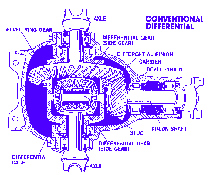
Thumbnail
There are three basic types of posi differentials. Limited slip, lockers, and spool. How do they differ?
Limited slip allows for some difference in wheel RPM between the two wheels.
Lockers do not allow any difference in wheel RPM until they are disengaged or overpowered.
Spool is solid locked and will not allow any difference in wheel RPM until something breaks (whether that be traction or steel).
Limited slips
There are two basic methods of getting limited slip.
The most common method is most commonly referred to as simply limited slip, but more correct is called a Clutch Based Limited Slip Differential. These use a spring loaded clutch between the two wheels that holds the wheel together until the clutches are overpowered.
Here is an image of a clutch based limited slip, there many variations in how the clutches a placed.
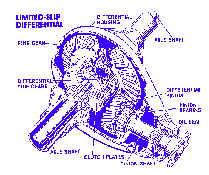
Thumbnail
The other is called a Torque Biasing Differential (also referred to as Torsional, or Torsen), and uses different types of gears to distribute force to each wheel properly, but still allows for a difference in wheel RPM on each side. There are also some torsional differentials that also use a clutch system in conjunction with the torsional effect. Only aggressive road course and autocross driving would effectively be able to utilize the benefits of this type of diff.
Here is an image of a torsional differential, though there are several different versions, they all consist of gears similar to this.
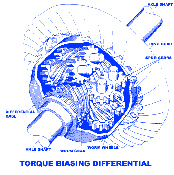
Thumbnail
Lockers and Spool the same?
Spool sometimes referred to as Full Spool, is simply a solid piece of metal that holds the wheels together. Lockers or Selectable Lockers are diffs that use some kind of interlocking surface to hold the wheels together, but the interlock can be undone as well. Basically they can work in two modes, either spooled or open.
Here is an image of a locker differential, the image is kind of complicated, but that is how they are. Though the exact design can very greatly.
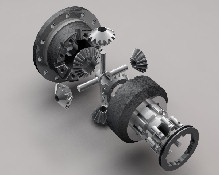
Thumbnail
Here is an image of a spool diff, pretty simple, solid chuck-o metal.
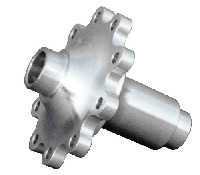
Thumbnail
So what does this mean to me?
As an example of the real life difference between the main types, suppose one wheel goes off in the gravel as you are accelerating around a road block while running from the entire police force just for fun.
Torsional
In the case of a torsion differential it balances power to each wheel to maintain the same RPM at each wheel. So as the right wheel goes off into the gravel, the differential will sense the right wheel beginning to spin which will result in a reduction of power to that wheel, this power is then transferred, or added to the left wheel. So let's say that you put down 300 ft*lbs of torque. So you put down 150tf*lbs to each wheel. With both wheels on pavement they can handle 500 ft*lbs before spinning. So one wheel can only handle 250ft*lbs be it self. But a wheel in gravel can only handle 75ft*lbs. As you put one wheel in the pavement, the diff transfers the excess 75ft*lbs to the other wheel. Now you are putting down 225ft*lbs on the left wheel, and 75ft*lbs on the right wheel. That means you are still at full acceleration with no wheel spin. But because the torsion differential does not try to hold the wheels together, but instead only balances the power, this means that in a turn the inside wheel is free to rotate slower than the outside as it is required to do, and without any negative effects from the differential.
Spool and Locker
In the case of a full spool, both wheels are forced to spin together no matter what. So with one wheel in gravel you get the same result as the torsion differential. However, in a turn the wheels are not able to spin independently. So the result is one of two things, either the wheels spin as a result of the tires losing grip because of a twisting moment generated in the axle, or the axle breaks. This twist in the axle results in force at each wheel in opposite directions, it keeps building until one wheel slips and relieves the stress. A locker works just the same as a spool, but is designed to become an open diff before any kind of metal breaks, or in the case of a selectable locker, only when you decide to.
Clutch Based
In the case of the clutch based diff there is a % difference in traction between the wheels in which the wheels will still spin at the same rate. In most cases this percentage on street or mild track use differentials is less than 40%. This means that if the traction of the right wheel is less than 40% different from the traction of the left wheel, they will still keep spinning the same RPMs. However, in the case of one wheel on gravel and the other on pavement, the difference is significantly greater than 40%. In this case the clutches reach their limit and one wheel begins to spin, this spinning results in relatively all your power going to forcing a wheel to spin, and not accelerating. However in the case of a turn, this % difference allows the wheels to spin independently with only some interference. This interference is equal to that % difference. So you now see that as you increase the strength of the diff (ie increase the % difference) you become more and more like a locked differential. Something else to note, is that the clutches can, and do, eventually wear out. This means that periodically (not that often) you do have to service them with new clutches. The other two only wear out if you manage to wear a gear down to nothing.
So why not use a Torsion diff on everything?
As I am sure you have noticed torsion diffs seem to have the market cornered. It has all the benefits of spool without the consequences in a turn, and outperforms clutch based limited slips in turns as well. So why do people not chose the torsion differentials all the time? Well for the most part, price. A conventional clutch based limited slip is less than half the price. The cheapest torsion diff is over $400 for just the part, not installation. Spooled diffs are good for people that have full time off-road vehicles or need to handle massive HP numbers (ie. full time dragsters). Off roaders like it because if you have one wheel in the air, you still get 100% power to the wheel on the ground, pretty much a must have for rock crawlers. In this case a torsion diff would not work as good, as it depends on that wheel being able to handle at least some force. A locker is nice for both these folks as you get the advantages of the spool, but can still drive it on pavement with some inconveniences in turns like tire chirping, clicking noise, and chatter. Unless it is a selectable locker which performs like an open diff when off, so you won’t get any streetable difference at all.
So now you know. Informed decisions make good decisions.
If you are interested in more information there is an abundance of it available through simple Google searches, now that you are familiar with some of the terminology used. But the link below is a good little read.
Toyota OffRoad.com article
This write-up is property of GrandMarq.net and should not be duplicated without permission.
First you should know what you are starting with, and open differential. These differentials use a system called spider gears to allow power to travel to each wheel, but also lets one wheel freely spin at a different rate than the other. This enable smooth operation in a turn, since the inside wheel will need to spin slower than the outside.
Here is an image of an open differential.

Thumbnail
There are three basic types of posi differentials. Limited slip, lockers, and spool. How do they differ?
Limited slip allows for some difference in wheel RPM between the two wheels.
Lockers do not allow any difference in wheel RPM until they are disengaged or overpowered.
Spool is solid locked and will not allow any difference in wheel RPM until something breaks (whether that be traction or steel).
Limited slips
There are two basic methods of getting limited slip.
The most common method is most commonly referred to as simply limited slip, but more correct is called a Clutch Based Limited Slip Differential. These use a spring loaded clutch between the two wheels that holds the wheel together until the clutches are overpowered.
Here is an image of a clutch based limited slip, there many variations in how the clutches a placed.

Thumbnail
The other is called a Torque Biasing Differential (also referred to as Torsional, or Torsen), and uses different types of gears to distribute force to each wheel properly, but still allows for a difference in wheel RPM on each side. There are also some torsional differentials that also use a clutch system in conjunction with the torsional effect. Only aggressive road course and autocross driving would effectively be able to utilize the benefits of this type of diff.
Here is an image of a torsional differential, though there are several different versions, they all consist of gears similar to this.

Thumbnail
Lockers and Spool the same?
Spool sometimes referred to as Full Spool, is simply a solid piece of metal that holds the wheels together. Lockers or Selectable Lockers are diffs that use some kind of interlocking surface to hold the wheels together, but the interlock can be undone as well. Basically they can work in two modes, either spooled or open.
Here is an image of a locker differential, the image is kind of complicated, but that is how they are. Though the exact design can very greatly.

Thumbnail
Here is an image of a spool diff, pretty simple, solid chuck-o metal.

Thumbnail
So what does this mean to me?
As an example of the real life difference between the main types, suppose one wheel goes off in the gravel as you are accelerating around a road block while running from the entire police force just for fun.
Torsional
In the case of a torsion differential it balances power to each wheel to maintain the same RPM at each wheel. So as the right wheel goes off into the gravel, the differential will sense the right wheel beginning to spin which will result in a reduction of power to that wheel, this power is then transferred, or added to the left wheel. So let's say that you put down 300 ft*lbs of torque. So you put down 150tf*lbs to each wheel. With both wheels on pavement they can handle 500 ft*lbs before spinning. So one wheel can only handle 250ft*lbs be it self. But a wheel in gravel can only handle 75ft*lbs. As you put one wheel in the pavement, the diff transfers the excess 75ft*lbs to the other wheel. Now you are putting down 225ft*lbs on the left wheel, and 75ft*lbs on the right wheel. That means you are still at full acceleration with no wheel spin. But because the torsion differential does not try to hold the wheels together, but instead only balances the power, this means that in a turn the inside wheel is free to rotate slower than the outside as it is required to do, and without any negative effects from the differential.
Spool and Locker
In the case of a full spool, both wheels are forced to spin together no matter what. So with one wheel in gravel you get the same result as the torsion differential. However, in a turn the wheels are not able to spin independently. So the result is one of two things, either the wheels spin as a result of the tires losing grip because of a twisting moment generated in the axle, or the axle breaks. This twist in the axle results in force at each wheel in opposite directions, it keeps building until one wheel slips and relieves the stress. A locker works just the same as a spool, but is designed to become an open diff before any kind of metal breaks, or in the case of a selectable locker, only when you decide to.
Clutch Based
In the case of the clutch based diff there is a % difference in traction between the wheels in which the wheels will still spin at the same rate. In most cases this percentage on street or mild track use differentials is less than 40%. This means that if the traction of the right wheel is less than 40% different from the traction of the left wheel, they will still keep spinning the same RPMs. However, in the case of one wheel on gravel and the other on pavement, the difference is significantly greater than 40%. In this case the clutches reach their limit and one wheel begins to spin, this spinning results in relatively all your power going to forcing a wheel to spin, and not accelerating. However in the case of a turn, this % difference allows the wheels to spin independently with only some interference. This interference is equal to that % difference. So you now see that as you increase the strength of the diff (ie increase the % difference) you become more and more like a locked differential. Something else to note, is that the clutches can, and do, eventually wear out. This means that periodically (not that often) you do have to service them with new clutches. The other two only wear out if you manage to wear a gear down to nothing.
So why not use a Torsion diff on everything?
As I am sure you have noticed torsion diffs seem to have the market cornered. It has all the benefits of spool without the consequences in a turn, and outperforms clutch based limited slips in turns as well. So why do people not chose the torsion differentials all the time? Well for the most part, price. A conventional clutch based limited slip is less than half the price. The cheapest torsion diff is over $400 for just the part, not installation. Spooled diffs are good for people that have full time off-road vehicles or need to handle massive HP numbers (ie. full time dragsters). Off roaders like it because if you have one wheel in the air, you still get 100% power to the wheel on the ground, pretty much a must have for rock crawlers. In this case a torsion diff would not work as good, as it depends on that wheel being able to handle at least some force. A locker is nice for both these folks as you get the advantages of the spool, but can still drive it on pavement with some inconveniences in turns like tire chirping, clicking noise, and chatter. Unless it is a selectable locker which performs like an open diff when off, so you won’t get any streetable difference at all.
So now you know. Informed decisions make good decisions.
If you are interested in more information there is an abundance of it available through simple Google searches, now that you are familiar with some of the terminology used. But the link below is a good little read.
Toyota OffRoad.com article
This write-up is property of GrandMarq.net and should not be duplicated without permission.




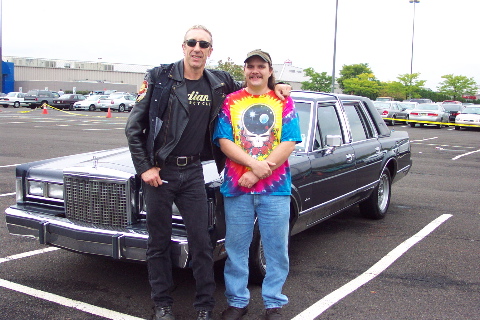

Comment